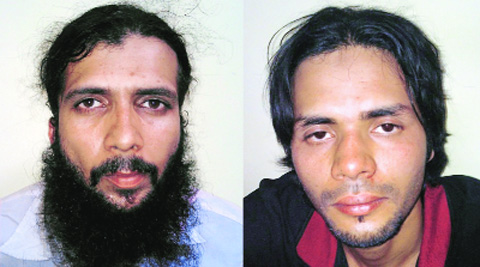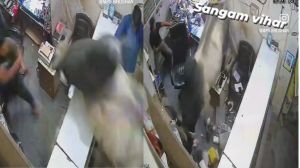- India
- International
Entire top Indian Mujahideen leadership nabbed in 8 months
Rahul Tripathi reports how the entire top leadership of the terror outfit in India has been arrested.
 Since 2008, more than 120 IM operatives have been held across the country.
Since 2008, more than 120 IM operatives have been held across the country.
Starting with Yasin, the entire top leadership of the terror outfit in India has been arrested RAHUL TRIPATHI reports how
In just over eight months, five agencies working together have netted the entire top leadership of the Indian Mujahideen in India. The operations, led by the Research and Analysis Wing (R&AW) and including Intelligence Bureau (IB), NIA, Delhi Police and Rajasthan Police, have been a result of human intelligence and surveillance and close coordination, for once unstymied by inter-agency rivalries.
Since 2008, more than 120 IM operatives have been held across the country. While it is clear that the IM is no more limited to a particular state or region — the recent captures show it’s spread all over, including Goa, Kerala, Orissa and Chhattisgarh — since Yasin’s arrest, the Patna attack of October 2013 has been the only one in India with an IM link.
According to officials, the breakthrough in the war against India’s homegrown terror outfit was the August 2013 arrest of Yasin Bhatkal, an IM co-founder and the head of its operations in India. Yasin was arrested from Nepal, where he had set up three different hideouts in the scenic town of Pokhra.
R&AW was first tipped off about Yasin’s presence by its assets in Nepal. This was confirmed by a courier sent by Yasin to his wife in Delhi in August 2013. Tahseen Akhtar acted as the courier, delivering a consignment of Rs 1 lakh. Indian agencies mounted a surveillance of Yasin’s wife’s mobile phone and, in a swift operation spread over a week, arrested him from Nepal. Asadullah, who was then staying with Yasin, came as a bonus catch. When Yasin was finally picked up, he did not resist and, in fact, confirmed that he was the man the officials were looking for.
This was a big boost for Indian agencies as Yasin had given them the slip at least three times earlier. Yasin, and later other IM operatives, have helped officials better understand terror modules, their behaviour, timing, method and pattern of attacks. Above all, Yasin has provided one crucial input: that most IM operatives are taught that when caught and made to chat with their Pakistani handlers or associates, they must not initiate a conversation. That is a signal that they have been arrested.

Increasing international cooperation has been another shot in the arm. Since 2012, countries such as Saudi Arabia and the UAE have deported several big prize catches, with the most recent being Abdul Wahid Siddibappa alias ‘Khan’, an alleged IM financer, from Dubai. He was identified based on Yasin’s interrogation and arrested following an NIA red corner notice. However, there has been a setback in getting him to India. With Delhi delaying sending a response, he was arrested and now has to be extradited rather than deported — a longer process.
Before ‘Khan’, Indian agencies had managed to get alleged IM mentor Fasih Mehmood and “Laskhar-e-Toiba operative” Sayed Zabiuddin Ansari alias Abu Jundal from Saudi Arabia in 2012.
The Delhi Police Special Cell team that arrested Waqas, a 24-year-old Pakistani national, from Ajmer last week says he was the first IM operative that the intelligence agencies started trailing, in September 2013, after Yasin’s arrest. Yasin told interrogators about Waqas’s possible hideout, based on which the NIA and IB raided a Mangalore flat two days later. However, Waqas managed to slip away.
R&AW then tracked his movement to Mumbai, where he had gone to receive hawala money. But officials differed over whether they should arrest him right away or wait for him to lead them to others. Sources concede that they also apprehended that the Mumbai police may not cooperate and the operation may fail. Earlier, a Delhi Police informer, Naqi Ahmed, had been held by Mumbai police for his alleged role in the 13/7 Mumbai blasts, leading to much bad blood between the two agencies.
They finally decided to wait for Waqas to travel out of Mumbai to arrest him, while monitoring him closely to avoid a Mangalore kind of embarrassment. On March 21 afternoon, Waqas boarded the general compartment of the Bandra-Ajmer Superfast train. On board was also a small police team (the Delhi Police deny this). The next morning, soon after the train pulled up at the Ajmer railway station, the Delhi Police team arrested Waqas.
Sources say Waqas proved surprisingly easy to crack, spilling details about the IM’s Rajasthan module. The intelligence agencies already had some information regarding the module from Yasin’s interrogation. Now they had the locations of its members.
Waqas was instructed to establish contact with Saquib Ansari, 25, at Jodhpur. Before he could get a hint that Waqas had been captured, a police team picked up Ansari early March 23 morning. Waqas was next made to contact on chat 21-year-old Mohd Mahruf and Waqar Azhar, who were picked up from Jaipur. While Ansari runs a DTP business, Mahruf and Azhar are engineering students. Officials say the three became members of the IM in 2012.
Their interrogation has allegedly revealed they had conducted a recee of tourist places in Agra and Jodhpur and that they planned to avenge the 2011 riots in Gopalgarh, Rajasthan.
Sources said Tahseen Akhtar, from Samastipur, Bihar, was held at the same time as Waqas. Waqas was allegedly in touch with Tahseen on way to Ajmer, and the much-wanted Tahseen, who had allegedly taken over as IM India head after Yasin’s arrest, was quickly traced and detained in Naxalbari, on the Indo-Nepal border, by the Delhi Police and central intelligence agencies.
Officials were again helped by the asset in Nepal, who confirmed Tahseen’s location. A photograph of Tahseen was dispatched to the team at the border to confirm his identity.
Tahseen’s arrest was shown only two days days later as investigators wanted to first use him to bust other modules. They also expected the IM leadership to try and contact Tahseen after the other arrests, and thought that could lead them to other men.
Officials particularly wanted to use Tahseen to find out other recruitments made by alleged IM talent scout Shafi alias Atta, a resident of Bhatkal, Karnataka, using social networking sites. The three members of the Rajasthan module arrested last week were reportedly recruited by Shafi this way. The IM’s use of social networking sites is a worrying trend, say officials, as it is similar to what the Lashkar-e-Toiba in Pakistan and al-Qaeda elsewhere do.
Apart from explosives, officials allegedly also seized mobile phones with records of chatting and use of various fake and proxy services to escape law enforcement agencies, from Waqas and Tahseen. One website commonly used by them was fakemailgenerator.com, which was then used to open accounts on chat IDs such as Nimbuzz.
The duo were also found trying to use freegate software, which allows users to bypass Internet firewalls and is mostly used by hackers to view websites blocked by governments. The mobile handset seized from Mahruf allegedly shows he had spoken to Riyaz 80 times using a proxy server.
IM operatives are instructed to never use Internet cafes. Every small message they exchange is generally encrypted.
The indoctrination material allegedly seized from Ansari and the others includes hate speeches and videos of “atrocities” committed in Afghanistan. The three in the Rajasthan module were allegedly told by Riyaz that they would get to fight NATO forces in Afghanistan.
Tahseen, who stayed with the three for more than six months in Jaipur and Jodhpur, allegedly also trained them in making IEDs, said a senior Delhi Police officer. Wanted in connection with blasts in Varanasi (2010), Mumbai (2011), Hyderabad (2013) and Patna (2013), Tahseen has reportedly admitted he had been taught to assemble IEDs and given physical training by Yasin, and that the two of them initially differed over Islam but later sorted out the matter. Police say Tahseen told them he was under the influence of an Ahl-e-Hadith sect moulvi, Ashfaque Salfi of Darbhanga.
Investigations conducted by the NIA and Delhi Police have also brought under the scanner the religious group Tablighi Jamat. IM operatives have told agencies the group organises tours and sermons where they highlight “atrocities” on Muslims.
Tahseen, who is considered highly motivated, wants the IM to distance itself from the ISI and align with al-Qaeda. The available evidence indicates that jehadis in Pakistan now identify themselves more with Taliban and that groups including the IM want to work with al-Qaeda and think of Osama bin Laden as their ‘amir’.
The two alleged Pakistani terrorists Abdul Waheed and Mohd Owais arrested by the Uttar Pradesh ATS last week from Gorakhpur, soon after the Rajasthan arrests, revealed they were trained at a Taliban camp in Afghanistan.
Another worrying trend, say officials, is the involvement of a section of the banned Students’ Islamic Movement of India (SIMI) with IM. SIMI men were believed to be behind the Bodhgaya and Patna blasts in July and October 2013. All college students, they are alleged to have been guided by Raipur SIMI activist Umer Siddhiqi, who was also arrested by the NIA.
Interestingly, arrested IM operatives have told officials the government should introduce the Sharia law to solve the problem of radicalisation.
On the other side
The IM structure changed after the September 2008 Batla House encounter. After the encounter, spooked engineer-turned-jihadist Riyaz Bhatkal and his brother Iqbal shifted to Pakistan and began calling the shots from there. This is believed to have caused acrimony between Riyaz and IM founder and chief Amir Reza Khan alias ‘Rizwan’, with the latter deciding to go his own separate way.
Apart from the Riyaz group, the IM now has two other factions. While top IM operative Dr Shahnawaz heads the group of Amir, the third faction is headed by Mohd Sajid alias Bada Sajid and Mirza Shadab Beig, who belong to Azamgarh in Uttar Pradesh and reportedly fought in Afghanistan against US forces.
Amir, meanwhile, has set up another group and continues to enjoy the patronage of the ISI, officials say.
A Unani doctor from Azamgarh, Shahnawaz’s brother Mohd Saif was arrested during the Batla House encounter. Shahnawaz is also related to Amir, having married his sister-in-law. Shahnawaz, it is believed, now recruits youths from Uttar Pradesh for the IM with the help of local contacts in SIMI. This group is also suspected to have been behind the Bodhgaya blasts.
While the split means that Riyaz’s faction has less financial support from the ISI, he gets help from other militant groups. Riyaz reportedly planned once to start a legal business in Nepal, where a large number of Indian businessmen are settled, as a cover to carry out strikes and transfer money.
At the time of his arrest,Yasin was practising medicine and was planning to open a wholesale medical shop with the name ‘Anmol’. The group was also desperate to carry out kidnappings and robberies for money.
According to one account, Iqbal Bhatkal was chosen as the ‘amir’ of IM’s Azamgarh module after the death of Atif Ameen in 2008. The selection was made in Dubai where scores of IM operatives fled after a crackdown in 2008. The group then moved to Pakistan.
A few years ago, some boys of the Azamgarh module revolted against Iqbal, who is learnt to have married a Pakistani woman.
Besides, while Riyaz was running his own module with Yasin’s help, the Azamgarh boys were not given any tasks by Iqbal, which frustrated them and they decided to fight in Afghanistan. A group led by Mirza Shadab Beig is now trying to allegedly forge an alliance with al-Qaeda and has denounced Iqbal as its ‘amir’.
From the interrogation of arrested IM operatives, it is suspected that the group will launch a new set of commanders who have been trained and are ready into India. One such name identified by Indian agencies is Salim Ishaqi, reportedly trained in a camp in Afghanistan to make timers.
Investigators are now working on identifying the remaining sleeper modules in the country.
“Our initial assessment was that the group had weakened with arrests and the division. But the IM has grown manifold. Each group has its men and logistics in India,” said a counter-terror official. Intelligence agencies estimate 40-50 youths from India are receiving training across the border.
Apr 26: Latest News
- 01
- 02
- 03
- 04
- 05








































